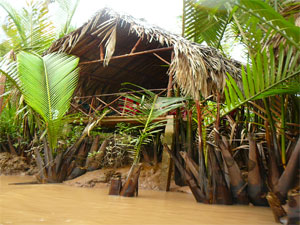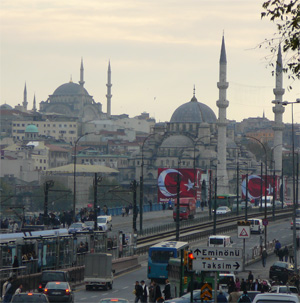TABLE
OF CONTENTS
|
Crossing the Globe: Using
Vernacular and Transnational to Guide me through a Global World
By Danica Taylor
This
journey has allowed my eyes and my mind to be opened into a world
that
without leaving the United
States I wouldn’t have known existed.
Throughout my sixteen years of formal education it has never been
hidden nor
denied that the United States is the economic powerhouse of the world
and is
hands down the most desirable country for immigrants to migrate to.
However, no
matter what textbook I read nor what teacher taught me, could I ever
have
learned what these true life experiences that each country have given
me? Traveling
to third world, or more politically correct, developing countries,
allowed me
see a glimpse of what it was like before the United States was
controlled by
corporations, consumerism and materialism.
The terms
vernacular
and transnational have allowed me to understand and grasp the true
nature and
identity of a global city, and the effects these changes have not only
on the country’s economy but the changes
the
people have to gradually adapt to. Countries like Vietnam
and Burma
allowed me to experience vernacular architecture, which
described by Henry Glassie are buildings that “embody values alien to
those
cherished in the academy” (pg. 20). Vernacular architecture consists of
architectural elements unstudied by common architects because it is not
taught
as something valuable in school, or “the academy.” But what Glassie
points out
in his book, Vernacular Architecture,
is that buildings that have been studied are therefore considered
important
because they hold some form of value to us as scholars, therefore
unimportant
or unstudied architecture is valueless. However, seeing these
untouched,
un-globalized nations where the vernacular beauty still lies was like a
breath
of fresh air from the claustrophobia experienced in countries like the US
where it is
impossible to escape the transnational world and vernacular
architecture is
nearly impossible to experience. The Burmese
villagers have never eaten a Big Mac nor have they ever seen the
Golden Arches for themselves. It’s not to say that they never will, but
this
does say that pure vernacular elements still exist in these countries,
elements
that identify their true culture and their heritage.
In stark
contrast to these
vernacular experiences, I have also traveled to Tokyo, Japan,
the world’s largest city; to Beijing,
China
a city which
set the record for the highest amount of economic growth and is a
forerunner
of being the next economic powerhouse; then, New Dehli, India
the world’s
most populous country with the fastest growing economy, another country
which
may one day become the world’s economic leader. All
of these cities have adapted to a transnational
world both structurally and culturally. Ulf Hannerz describes a
transnational
city in the article, "The Cultural Role of
World Cities" as “a city where the people involved are physically
present in
the world cities for some larger or smaller parts of their lives, but
they also
have strong ties to somewhere else in the world” (pg. 3).
These “involved people” are the channel in
which cities or nations become connected to the rest of the developed
world. Cultures,
traditions, businesses, and ideas begin transmitting across invisible
country lines
bringing all parts of the world closer and closer, creating what we now
know as
a global city.
But what
does all of this mean?
Onookome Okome describes this phenomenon as “the age of the city. The
city is
everything to us – it consumes us, and for that reason we glorify it”
(Verso,
1). We live in a world where everyone desires westernization, where the
rising
of McDonald’s golden arches symbolizes a country as one step closer to
becoming
developed.
Vietnam: War Tours?
Turkey: Beauty and
Benefits of a Global City
I have been
able to easily use the
definitions of vernacular and transnational elements to help me in
assessing
what stage of development the nation is in. In Vietnam I described the
thatched
roof houses, and how the families inside have had to adapt to the
westerners
visiting, touring their homes, and trying to capture the beauty and
simplicity
of their homes. How simple their lives remain, although the
transnational world
is already penetrating their homes. But still the
houses along side of the Mekong Delta
don’t have satellites hanging from them, nor do they have IKEA
furniture. On the other hand, I also saw
the development efforts going into westernizing Ho Chi Minh City. While we were there
a tour
guide said that both McDonald’s and Wal-Mart had plans of entering Vietnam
within
the near future. These plans are a classic sign of a nation taking the
necessary steps to moving into the global world of transnationalism. I
also explored the significance and impact that transnationalism and the
global
world can have on a country and the benefits it can provide for its
citizens.
In Turkey
I felt I experienced and saw
more transnational elements of globalization than in any other European
country. Turkey
has yet to join the European Union, but has plans for gaining
acquisition to
the union in 2015. Turkey
is making many structural changes in the government and policies to
gain
international support. Besides these structural changes Turkey
has fully adapted to a
transnational world. There were transnational corporations everywhere
you
looked, Burger King, McDonald’s, United Colors of Bennetton, Adidas,
Lacoste,
and many others lined the streets. The men and women showed a sincere
dedication to appearance and presentation, and there were internet and
wireless
cafes on every street corner. Istanbul
has capitalized from a transnational world, and is continuing to work
towards
becoming a nation that is all encompassing of transnational elements.
Through my
travels I have been able
to see for myself what the process of going global requires, the
industrialization, westernization
and adjustments not only to structures, but also to cutlures and daily
lives. Every day the globe is getting smaller
and smaller. Mass communications and transnational corporations
investmenting in nations that would otherwise not have the capital,
infrastructure, nor governmental
strength to join the transnational world. The global assistance in
this process is allowing the developing nations to position themselves
competitively
within the developing world.
|


